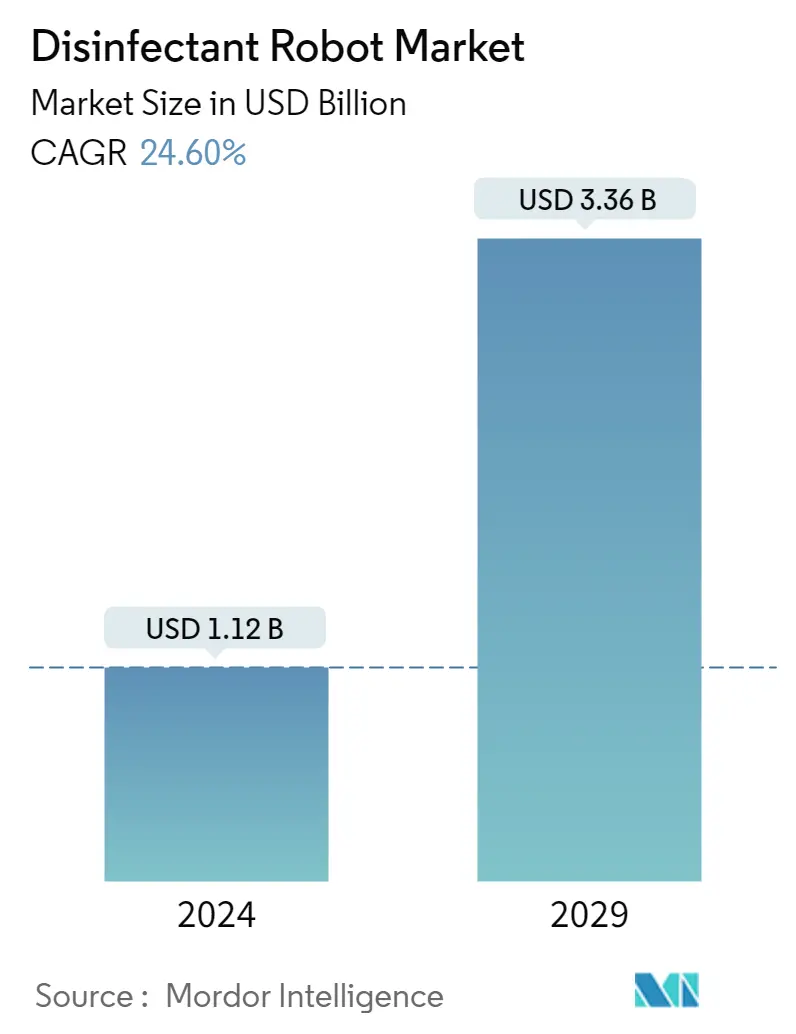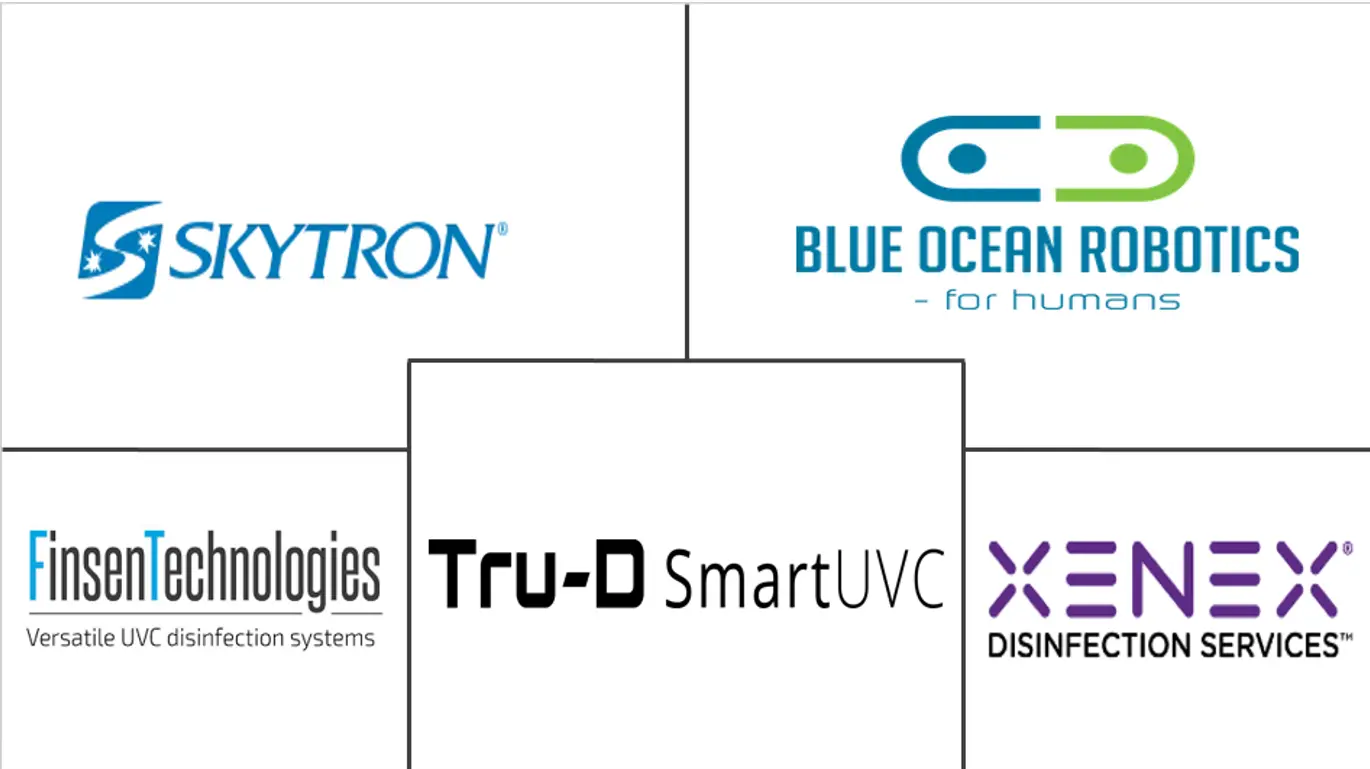Market Size of Disinfectant Robot Industry

| Study Period | 2019 - 2029 |
| Market Size (2024) | USD 1.12 Billion |
| Market Size (2029) | USD 3.36 Billion |
| CAGR (2024 - 2029) | 24.60 % |
| Fastest Growing Market | North America |
| Largest Market | Asia-Pacific |
| Market Concentration | Low |
Major Players
*Disclaimer: Major Players sorted in no particular order |
Disinfectant Robot Market Analysis
The Disinfectant Robot Market size is estimated at USD 1.12 billion in 2024, and is expected to reach USD 3.36 billion by 2029, growing at a CAGR of 24.60% during the forecast period (2024-2029).
The rapid rise in healthcare and sanitation spending due to the COVID-19 Outbreak and high investments in the field of disinfectant robots has increased the demand for growth in the market.
- Recently, the need for disinfection robots increased in order to decrease HAIs without adding to personnel expenditures. Processes like hydrogen peroxide and ultraviolet disinfection are carried out by manual labor because disinfection robots are still relatively recent inventions in the healthcare market in many nations. The pharmaceutical sector has been utilizing UV-C in cleanroom settings for more than ten years.
- The industry is primarily observing a trend of mobile robots that can UV-sanitize spaces. The market under study will advance due to the rising need for service robots, particularly in the healthcare sector.
- Sanitizing and disinfectant have become an area of concern, especially in highly populated areas, including hospitals, restaurants, hotels, airports, and schools. Due to this, the market is witnessing more companies and institutions that shifted to automation for disinfecting applications, hence, investing in robots.
- The higher costs of disinfectant robots are associated with effective and robust hardware and efficient software. Automation equipment includes higher capital expenditure required to invest in automation technologies (an automated system can cost millions of dollars to design, fabricate, and install). And with increasing advancement and functionality, the cost also increases.
- The COVID -19 pandemic increased and highlighted the value of robotic and automated technology. In addition to assisting in overcoming the difficulties faced by the human workforce during the pandemic, these technologies substantially reduce the virus's impact.
Disinfectant Robot Industry Segmentation
Disinfectant robots generally leverage HPV, UV-C, or other disinfection technologies to destroy viruses and deactivate pathogens and bacteria from air or surfaces. The need for disinfection robots has evolved recently to reduce hospital-acquired infections (HAIs) without incurring additional labor costs. The disinfectant robot market is segmented by product type (UV-C and HPV) and geography. The market sizes and forecasts are provided in terms of value (USD million) for all the above segments.
| Product Type | |
| UV-C | |
| HPV and Others |
| Geography | |
| North America | |
| Europe | |
| Asia Pacific | |
| Rest of the World |
Disinfectant Robot Market Size Summary
The disinfectant robot market is experiencing significant growth, driven by increased demand for automated sanitation solutions in various sectors, particularly healthcare. The COVID-19 pandemic has accelerated the adoption of these technologies, highlighting their importance in reducing healthcare-associated infections without adding to personnel costs. The market is characterized by the development of advanced mobile robots capable of UV sanitization, with a focus on enhancing safety features and operational efficiency. The introduction of second and third-generation robots, which incorporate machine learning and IoT connectivity, has further propelled the market forward, offering improved functionality and safety measures. These advancements have made disinfectant robots more appealing to a broader range of customers, including high-end hospitals and other institutions requiring robust sanitation solutions.
The Asia Pacific region is emerging as a key player in the disinfectant robot market, with countries like China, Japan, South Korea, and India leading in production and investment. The region's growing market share is supported by its status as a global hub for robot manufacturing and innovation. Local vendors and start-ups are actively participating in the market, contributing to its expansion through investments and technological advancements. The competitive landscape is marked by high rivalry among major players, who are striving to enhance their market share through product innovation and strategic partnerships. The market's growth trajectory is further supported by significant investments in robotic technologies, as seen in recent funding activities and strategic acquisitions by companies like Blue Ocean Robotics and Reliance Strategic Business Ventures Limited.
Disinfectant Robot Market Size - Table of Contents
-
1. MARKET INSIGHTS
-
1.1 Market Overview
-
1.2 Industry Attractiveness - Porter's Five Forces Analysis
-
1.2.1 Bargaining Power of Suppliers
-
1.2.2 Bargaining Power of Consumers
-
1.2.3 Threat of New Entrants
-
1.2.4 Threat of Substitutes
-
1.2.5 Intensity of Competitive Rivalry
-
-
1.3 Industry Stakeholder Analysis
-
1.4 Market Opportunities
-
1.5 Major Partnerships and Collaborations
-
1.6 Key Technical and Social Considerations in the Deployment of Disinfectant Robots
-
1.7 Impact of COVID-19 on the Market
-
-
2. MARKET SEGMENTATION
-
2.1 Product Type
-
2.1.1 UV-C
-
2.1.2 HPV and Others
-
-
2.2 Geography
-
2.2.1 North America
-
2.2.2 Europe
-
2.2.3 Asia Pacific
-
2.2.4 Rest of the World
-
-
Disinfectant Robot Market Size FAQs
How big is the Disinfectant Robot Market?
The Disinfectant Robot Market size is expected to reach USD 1.12 billion in 2024 and grow at a CAGR of 24.60% to reach USD 3.36 billion by 2029.
What is the current Disinfectant Robot Market size?
In 2024, the Disinfectant Robot Market size is expected to reach USD 1.12 billion.

